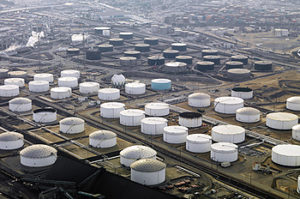 Many factors are involved in moving or trading bulk volumes of liquid petroleum and other products. The value of the product is usually determined by an independent inspection company who uses their own equipment to calculate the volume, purity and other required specifications. These inspection companies are responsible for providing the most accurate information possible from circumstances which are highly variable.
Many factors are involved in moving or trading bulk volumes of liquid petroleum and other products. The value of the product is usually determined by an independent inspection company who uses their own equipment to calculate the volume, purity and other required specifications. These inspection companies are responsible for providing the most accurate information possible from circumstances which are highly variable.
Within the storage vessel (tank, ship, barge, railcar, etc.) walls are irregular, temperatures of the product are stratified, quality of the product is stratified, and water may cover the bottom. While gathering data on the stored product, caution must be taken in this usually hazardous environment. All equipment used in the hazardous location near the vessel must be intrinsically safe†.
Petroleum products have a high rate of thermal expansion which must be taken into account when several thousand barrels are transferred or purchased. The temperature of a product can expand or contract the total volume a significant amount and therefore must be corrected to a standard volume at 60 degrees Fahrenheit. To obtain the correct volume of product within a storage tank, an average of temperatures taken at several levels must be obtained. For most petroleum the instrument must have an accuracy of + 0.2 °F / 0.1 °C.
A “strapping table” of the vessel determines the volume of the vessel at different levels. This table takes into account any pipes, ladders, or objects which may be within the vessel. The table also shows top and bottom reference points within the vessel.
The level of the liquid within a vessel can be determined with a calibrated steel tape and bob, or other ullage measuring devices. By measuring from a reference at the top of the vessel to the surface of the product, the level and liquid volume can be obtained with the aid of the strapping tables. After the ullage is taken, then the water and sludge at the bottom must be determined and subtracted. This can be done by coating the gauging tape with a special paste that changes color when in contact with water or by electronic means.
After the volume of the petroleum product within the vessel is derived a temperature/volume correction must be made. Depending on the classification of the petroleum being gauged, different “API Tables” (API Chapter 11) are used to calculate the volume correction factor. After this the correct volume of the product is known.
ThermoTab Volume Correction Application
Samples from within the vessel are sent back to the laboratory for further information regarding the quality of the product.
The most commonly used instruments to determine the temperature of petroleum inventories are the ThermoProbe digital tank gauging thermometers. The instruments are very accurate and tested to be intrinsically safe.
Depending on model and testing in progress, these safety marks are displayed on ThermoProbe products:
![]()
ThermoProbe instruments are currently used by major international inspection companies such as: Bureau Veritas, SGS, Intertek and Core Saybolt.
ThermoProbe’s customer list includes, Marathon, Chevron, Exxon, Nustar, TransMontaige, Total, Statoil, Conoco, Caltex, and many others.
Many for-hire storage facilities and pipelines use the instruments to monitor inventories and calibrate other equipment.
ThermoProbe thermometers are marketed by our numerous representatives located throughout the world.
* In this text the word Petroleum is used to describe any petroleum product or chemical which is subject to volumetric expansion due to temperature.
† Intrinsic Safety is a protection concept employed in potentially explosive atmospheres.
‡ Unfilled space between liquid level and top reference point.




